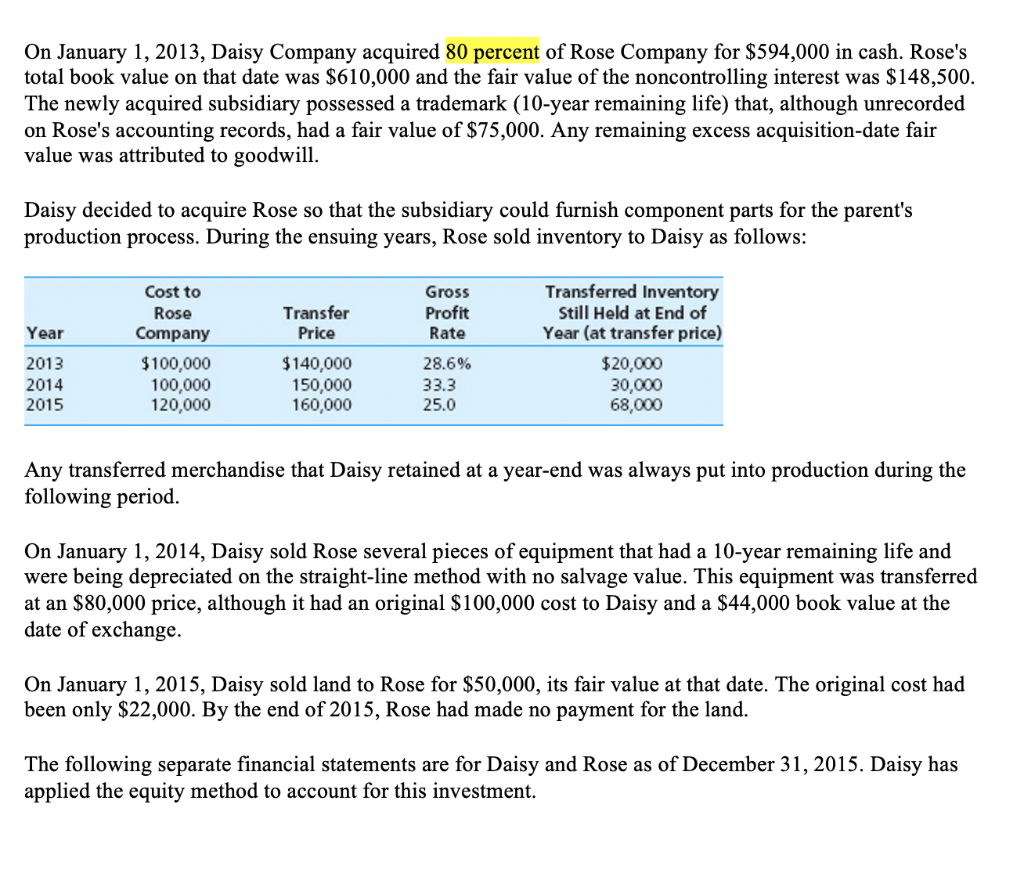

On January 1, 2013, Daisy Company acquired 80 percent of Rose Company for $594,000 in cash. Rose's total book value on that date was $610,000 and the fair value of the noncontrolling interest was $148,500. The newly acquired subsidiary possessed a trademark (10-year remaining life) that, although unrecorded on Rose's accounting records, had a fair value of $75,000. Any remaining excess acquisition-date fair value was attributed to goodwill. Daisy decided to acquire Rose so that the subsidiary could furnish component parts for the parent's production process. During the ensuing years, Rose sold inventory to Daisy as follows: Transfer Price Gross Profit Rate Year Cost to Rose Company $100,000 100,000 120,000 Transferred Inventory Still Held at End of Year (at transfer price) $20,000 30,000 68,000 2013 2014 2015 $140,000 150,000 160,000 28.6% 33.3 25.0 Any transferred merchandise that Daisy retained at a year-end was always put into production during the following period. On January 1, 2014, Daisy sold Rose several pieces of equipment that had a 10-year remaining life and were being depreciated on the straight-line method with no salvage value. This equipment was transferred at an $80,000 price, although it had an original $100,000 cost to Daisy and a $44,000 book value at the date of exchange. On January 1, 2015, Daisy sold land to Rose for $50,000, its fair value at that date. The original cost had been only $22,000. By the end of 2015, Rose had made no payment for the land. The following separate financial statements are for Daisy and Rose as of December 31, 2015. Daisy has applied the equity method to account for this investment. Rose Company $ (500,000) 300,000 80,000 0- Sales Cost of goods sold. Operating expenses Gain on sale of land.. Equity in earnings of Rose Company Net income Retained earnings, 1/1/15 Net income. Dividends declared Retained eamings, 12/31/15 Cash and accounts receivable Inventory.... Investment in Rose Company. Land Equipment. Accumulated depreciation. Total assets Liabilities Common stock Retained earnings, 12/31/15 Total liabilities and equities. Daisy Company $ (900,000) 598,000 210,000 (28,000) (60,000) $ (180,000) $ (620,000) (180,000) 55,000 $ (745,000 $ 348,000 430,400 737,600 454,000 270,000 (180,000) $2,060,000 (715,000) (600,000) (745,000) $(2,060,000 $ (120,000) $ (430,000) (120,000) 50,000 $ (500,000 $ 410,000 190,000 280,000 190,000 (50,000) $1,020,000 (120,000) (400,000) (500,000) $(1,020,000) Required: a) Prepare the consolidation entries required at December 31, 2015, for the transfer of inventory. b) Prepare the consolidation entries required at December 31, 2015, for the transfers land and equipment. On January 1, 2013, Daisy Company acquired 80 percent of Rose Company for $594,000 in cash. Rose's total book value on that date was $610,000 and the fair value of the noncontrolling interest was $148,500. The newly acquired subsidiary possessed a trademark (10-year remaining life) that, although unrecorded on Rose's accounting records, had a fair value of $75,000. Any remaining excess acquisition-date fair value was attributed to goodwill. Daisy decided to acquire Rose so that the subsidiary could furnish component parts for the parent's production process. During the ensuing years, Rose sold inventory to Daisy as follows: Transfer Price Gross Profit Rate Year Cost to Rose Company $100,000 100,000 120,000 Transferred Inventory Still Held at End of Year (at transfer price) $20,000 30,000 68,000 2013 2014 2015 $140,000 150,000 160,000 28.6% 33.3 25.0 Any transferred merchandise that Daisy retained at a year-end was always put into production during the following period. On January 1, 2014, Daisy sold Rose several pieces of equipment that had a 10-year remaining life and were being depreciated on the straight-line method with no salvage value. This equipment was transferred at an $80,000 price, although it had an original $100,000 cost to Daisy and a $44,000 book value at the date of exchange. On January 1, 2015, Daisy sold land to Rose for $50,000, its fair value at that date. The original cost had been only $22,000. By the end of 2015, Rose had made no payment for the land. The following separate financial statements are for Daisy and Rose as of December 31, 2015. Daisy has applied the equity method to account for this investment. Rose Company $ (500,000) 300,000 80,000 0- Sales Cost of goods sold. Operating expenses Gain on sale of land.. Equity in earnings of Rose Company Net income Retained earnings, 1/1/15 Net income. Dividends declared Retained eamings, 12/31/15 Cash and accounts receivable Inventory.... Investment in Rose Company. Land Equipment. Accumulated depreciation. Total assets Liabilities Common stock Retained earnings, 12/31/15 Total liabilities and equities. Daisy Company $ (900,000) 598,000 210,000 (28,000) (60,000) $ (180,000) $ (620,000) (180,000) 55,000 $ (745,000 $ 348,000 430,400 737,600 454,000 270,000 (180,000) $2,060,000 (715,000) (600,000) (745,000) $(2,060,000 $ (120,000) $ (430,000) (120,000) 50,000 $ (500,000 $ 410,000 190,000 280,000 190,000 (50,000) $1,020,000 (120,000) (400,000) (500,000) $(1,020,000) Required: a) Prepare the consolidation entries required at December 31, 2015, for the transfer of inventory. b) Prepare the consolidation entries required at December 31, 2015, for the transfers land and equipment








